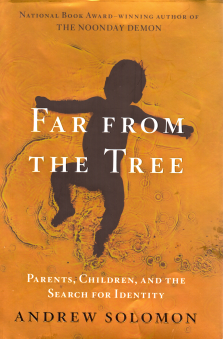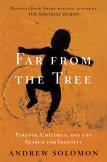Extreme Parenting
Andrew Solomon’s new book is a masterpiece of dogged research and persuasive writing. Solomon interviewed more than 300 families to learn how parents cope with severely handicapped or difficult children. The chapter titles indicate the book’s breathtaking scope: “Deaf, Dwarfs, Down Syndrome, Autism, Schizophrenia, Disability, Prodigies, Rape, Crime, Transgender.”
Parents of these children suffer emotionally and physically—wracked by feelings of guilt and failure. Divorce, regret and depression are common.
And yet the author found that for the majority of parents the dominant feeling was love. “This book’s conundrum,” he writes, “is that most of the families described here have ended up grateful for experiences they would have done anything to avoid.” One parent said that raising a Down syndrome child was “the most difficult but also the most enriching experience of my life.” Solomon is well qualified to write about handicaps. As a child he suffered from severe dyslexia. His parents were told that he would never learn to read or write. As an adult, he wrote an acclaimed book, The Noonday Demon, about his long battle with depression. He also struggled to come to terms with his homosexuality.
The book’s title refers to the adage that the apple does not fall far from the tree, meaning that children generally resemble their parents. The children profiled here have fallen “elsewhere—some a couple of orchards away.”
Solomon distinguishes between vertical and horizontal identity. Vertical defines characteristics inherited from parents, like skin color, while horizontal embraces “values and preferences,” like homosexuality, that children do not share with their parents.
A recurring theme involves the growing use of amniocentesis to detect flaws and the decisions by some women to abort fetuses with severe abnormalities. Others view this practice as a form of genocide against the handicapped.
Autism is a severe disability of unknown cause that sometimes involves bizarre behavior. Solomon lists a whole page of parents who in desperation resorted to filicide, including among the victims young children, teenagers and even older offspring, “to spare those children suffering.” Although some people with autism cannot function in society, some are brilliant. The author lists famous people, including Thomas Jefferson, Mozart and Einstein, who probably had Asperger syndrome.
A rape victim faces the extraordinarily difficult decision of when and how to tell a child that he or she was conceived in a violent assault.
Solomon believes that schizophrenia “may be in a class by itself for unrewarding trauma.” It runs in families and usually manifests itself in adolescence or early adulthood, when sufferers hear strange voices and sometimes become violent. One father of a schizophrenic said after his son was hit by a truck but survived, “Frankly, it would have been better if he’d died. Better for him, better for everybody.”
The parents of young criminals understandably are wracked by anger and guilt. Although criminality is not inherited, some children “seem to be born without a moral center.” Solomon suggests that locking up young offenders for decades only hardens their criminal behavior.
One comes away from this book with appreciation for Solomon’s compassion and his meticulous search for causes and treatment, along with historical perspective in each of the 10 categories.
He notes that dwarfs, now called little people, still appear in freak shows and dwarf-tossing competitions, “testimony to a callousness beyond that shown to almost any other disabled group.” Some parents resort to the controversial practice of limb-lengthening, by which doctors repeatedly break a child’s leg bones and stretch the muscles.
Society has become more enlightened about the disabled, but debates about acceptance, care and cures still rage. As recently as 2006, the Royal College of Obstetricians and Gynecol-ogists in London was reported to have proposed that doctors consider killing infants with extreme disabilities.
Most of the people interviewed found it odd that they were being grouped together in this book. Deaf people, for example, did not want to be compared with those suffering from schizophrenia. But the power of this book is that it shows the common emotions and challenges—as well as the differences—facing parents in the 10 categories.
I agree generally with the rave reviews that have greeted this book, with minor reservations. The text was reduced in length by half before publication, but it could have been cut more. The many case histories in each chapter begin to sound redundant.
Nevertheless, Solomon has made a major contribution to our understanding of family and identity.
He ends with these words, “Sometimes, I had thought the heroic parents in this book were fools, enslaving themselves to a life’s journey with their alien children, trying to breed identity out of misery. I was startled to learn that my research had built me a plank, and that I was ready to join them on their ship.”
This article also appeared in print, under the headline “Extreme Parenting,” in the April 29, 2013, issue.








